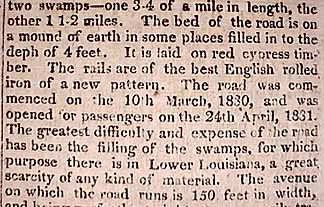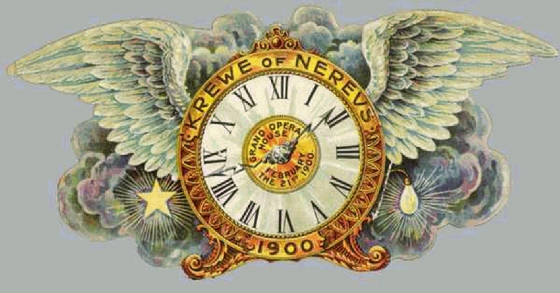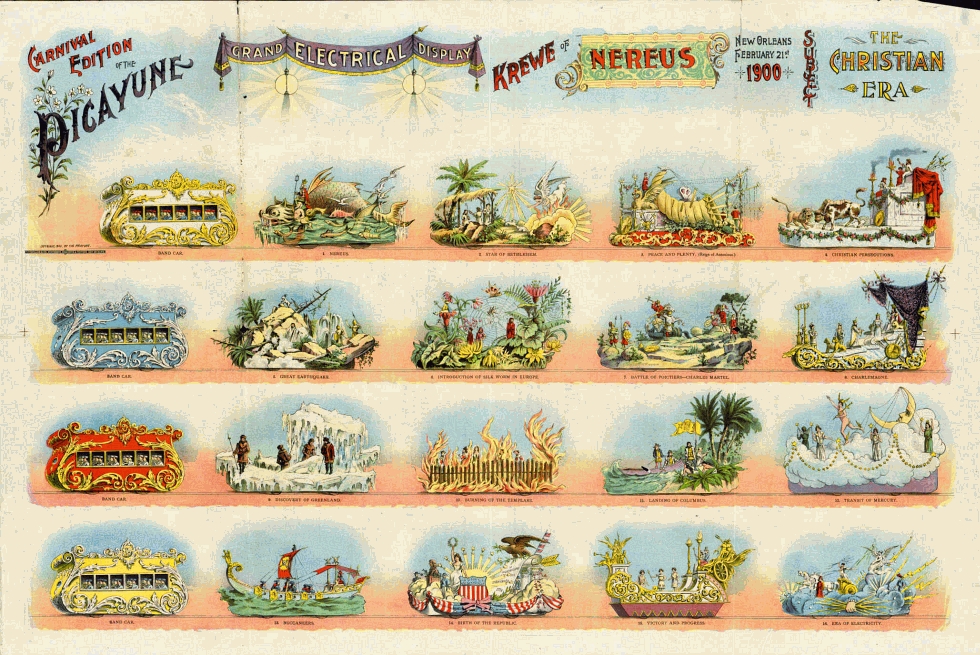
First
Electrically Lit Parade
The
Krewe of Nereus
Wednesday, February 21, 1900
Invitation to the Krewe of Nereus' Carnival ball, held at the
Grand Opera House on February 21, 1900. Thinking to usher in a new, modern age, Nereus chose to greet the new century with
a "Grand Electric Display" (note the electric light bulb on the invitation). Its parade was the first (and the last!)
ever to be mounted on streetcar trucks. The effort, writes Perry Young in The Mystick Krewe, was a failure:
Sixteen
gorgeous tableaux were mounted on regulation trolley trucks, the last and most triumphant scene representing the Era of Electricity.
Four bands on trolley cars were interspersed in the procession. The parade was certainly a pronounced and undeniable success,'
said the Times-Democrat. But the newspaper was alone in the opinion, and nothing like it ever again was attempted. The trolley
poles reaching up through the decorations were monuments too modern for the medieval fete. Electric lighting had the same
fixed and artificial incongruity as the trolley poles. Delays were worse than any ever caused by men or mules, the cars became
separated to intervals of three, four, and five city squares, and the curtain did not rise at the Grand Opera House until
11:15 o'clock. It caused also a tremendous expense, and Nereus retired in his next year to tableau balls. Text
and photo from the New Orleans Public Library.
The Krewe of Nereus' first and only parade in 1900 included 16 floats and four bands -- all
riding along the streetcar tracks.
Named for the Greek God of
the Sea, the krewe was organized in 1895. On February 3, 1896, the krewe's innaugural ball was themed “Sea Views”
-- the queen was Miss May Van Benthuysen. For their 1897 ball, themed “Coral Groves and Grottoes”, a 100-foot
structure designed as a mythical fire-breathing Nordic sea monster, supported by fifteen men, writhed across the floor of
the opera house though reproductions of underwater caverns. The 1912 ball, titled “A Christmas Party”
had Santa Claus calling the call-outs to the stage and giving each lady an envelope containing the number of her masker
for the first dance.
The 1900 Mardis Gras was the first
to be extended beyond the Monday and Tuesday before Lent. Nereus became the first krewe to parade on the Wednesday before
Lundi Gras. It kicked off the parade season which ran from February 21 to February 27, 1900. Nereus continues
today to celebrate the Carnival season by holding an annual ball.
You Can Support this Site by Clicking on & Shopping from this Amazon Link -- and it
won't cost you a penny more:


Carnival Day was celebrated on February 21 in 2012, 1950, and 1939. It will fall on the same date
in 2023, 2034, and 2045.
On Monday February 21,
1979 (Lundi Gras Day), the Meters performed at Tipitini's, 501 Napoleon Avenue.
Famous silent film and network radio organist for soap operas and dramas, Rosa Rio (Elizabeth Raub) visited
the New Orleans Saenger Theatre on
February 21, 1976 and played the theatre's organ. She continued to perform
until the age of 107,
becoming one of the oldest performers in the music industry.
The Gentilly streetcar ran from February 21, 1926 until July 17, 1948. Gentilly was
derived from the old Villere Line. It was unusual in being named for the neighborhood it served, rather than the street
along which it ran. At one end, it traversed the French Quarter. Then it turned up Almonaster (now Franklin) to its terminal
at Dreux. Replaced by diesel bus service, which was eventually renamed Franklin for the street.
The St. Claude Avenue streetcar ran its last route on January 1, 1949. Beginning on
February 21, 1926, it and the Gentilly Line were the last two streetcar lines to open in New Orleans until August
1988 with the inauguration of the Riverfront line. St. Claude's streetcars were replaced with a trolley bus and later
diesel bus service.
John Edward Bouligny, congressman. Born, probably Plaquemines Parish, La., February 5, 1824; son of Louis
Bouligny (q.v.) and Elizabeth Virginie d'Hauterive. Grew up in Jefferson Parish, and probably attended the local public
schools. Attained prominence after the death of his older brother François Bouligny (1819-1857), who was mayor
of Lafayette, Jefferson Parish, when it became the Fourth Municipal District of New Orleans in 1852 and elected recorder
of the Fourth District in 1856. In 1859 elected to Congress from the First Congressional District as the only successful
Louisiana candidate of the American (Know-Nothing) Party, which was firmly opposed to secession. On February 5, 1861,
when news that Louisiana had seceded reached Washington, he made a speech on the floor of the House declaring his steadfast
loyalty to the Union and his intention to serve out his term; was the only Southern congressman who remained in Washington
after his state seceded. Married Mary E. Parker in Washington in 1861. No children. In late 1862 returned
to New Orleans (then under Union occupation) to run for reelection, armed with a letter of recommendation from President
Lincoln to Gen. Benjamin Butler (q.v.); failed to gain Butler's support and was defeated. Returned to Washington.
Died, Washington, D. C., February 21, 1864; interred Congressional Cemetery. F.M. Sources:
Bouligny-Baldwin Papers, The Historic New Orleans Collection; St. Louis Cathedral Vital Records; L. C. Soulé, The
Know Nothing Party in New Orleans (1962); Collected Works of Abraham Lincoln; Congressional Globe, February 7, 1861); New
Orleans Daily Picayune, December 4, 1862; New Orleans Daily Delta, December 4, 1862; obituaries, New York Times and
Washington Evening Star, February 22, 1864. From http://lahistory.org/site19.php
 This newspaper clipping from the February 21, 1831 issue of the United States Weekly Telegraph newspaper
published in Washington, DC by Duff Green is part of a 1/2 page report about the Pontchartrain Railroad (AKA The Smokey Mary)
in New Orleans. The report describes the route and construction of the Railroad that connected Lake Pontchartrain and the
city.
This newspaper clipping from the February 21, 1831 issue of the United States Weekly Telegraph newspaper
published in Washington, DC by Duff Green is part of a 1/2 page report about the Pontchartrain Railroad (AKA The Smokey Mary)
in New Orleans. The report describes the route and construction of the Railroad that connected Lake Pontchartrain and the
city.









 This newspaper clipping from the February 21, 1831 issue of the United States Weekly Telegraph newspaper
published in Washington, DC by Duff Green is part of a 1/2 page report about the Pontchartrain Railroad (AKA The Smokey Mary)
in New Orleans. The report describes the route and construction of the Railroad that connected Lake Pontchartrain and the
city.
This newspaper clipping from the February 21, 1831 issue of the United States Weekly Telegraph newspaper
published in Washington, DC by Duff Green is part of a 1/2 page report about the Pontchartrain Railroad (AKA The Smokey Mary)
in New Orleans. The report describes the route and construction of the Railroad that connected Lake Pontchartrain and the
city. 
